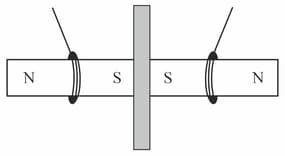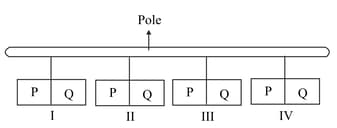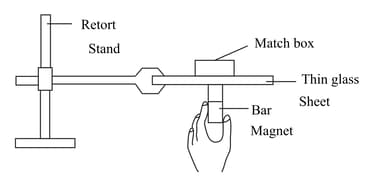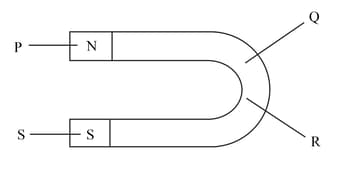Two bar magnets suspended by string, are separated by a piece of metal. Which of the following statements best explain the outcome shown in the diagram?

Important Questions on Fun with Magnets
When Asha suspended four bars of different materials from a pole and brought the North pole of a bar magnet near part and of each bar one by one as shown in the figure, the observations she recorded are as follows:

| Bar | Magnet and part | Magnet and part |
| Repel | Attract | |
| Nothing happened | Nothing happened | |
| Attract | Repel | |
| Attract | Attract |
Which of the following sets correctly represents metal bars and ?
| Bar | Bar | Bar | Bar | |
| (A) | Magnet | Wooden bar | Magnet | Iron bar |
| (B) | Magnet | Iron bar | Magnet | Glass bar |
| (C) | Stainless Magnet steel bar | Magnet | Iron bar | Magnet |
| (D) | Magnet | Iron bar | Glass bar | Stainless steel bar |
Arun suspended a bar magnet on a string as shown in the diagram below. He brought bar-shaped objects and towards the bar magnet. He placed the ends ( and ) of each object, near the north pole of the bar magnet and recorded his observations in the table below.

| Object | End brought near to pole | End brought near to pole |
| pole repelled | pole attracted | |
| pole attracted | pole repelled | |
| pole remains stationary | pole remains stationary |
Which of the object(s) is/are the magnet?

A matchbox containing an unknown object is placed on a thin sheet of glass in the experimental set-up shown in the figure.

When the bar magnet moves, it is able to drag the match box along. What is most likely to be found in the matchbox?
What will happen when three bar magnets are hung in the manner as shown below?


| (A) | ||||
| (B) | ||||
| (C) | ||||
| (D) |
